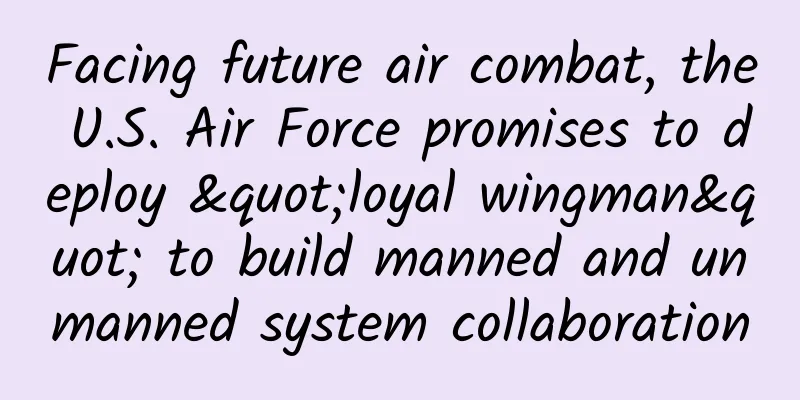Facing future air combat, the U.S. Air Force promises to deploy "loyal wingman" to build manned and unmanned system collaboration

|
The U.S. Air Force (USAF) is ready to move beyond experiments with unmanned combat aircraft and toward acquiring and fielding the next generation of unmanned aerial vehicles (UAVs). At the 2022 Defense Outlook virtual conference held on December 9, 2021, U.S. Air Force Secretary Frank Kendall said that deploying "Loyal Wingman" drones is a top priority for the military service. Source: U.S. Air Force Research Laboratory "Loyal wingmen" like Kratos' XQ-58A Valkyrie demonstrator can operate in tandem with manned aircraft. The picture shows the "loyal wingman" jointly developed by Boeing and Australia The U.S. Air Force has been experimenting with "loyal wingman" drones in recent years. However, the Air Force has not yet committed to fielding unmanned fighter jets. The Air Force is analyzing and preparing to move technologies developed in the experiment into full development and then into production programs. “It’s going to take a while for us to work through all of this, and then we’re going to start working on some of the things that we’re going to be working on,” Kendall said. “This is a commitment to move in directions that we’ve been thinking about and experimenting with but hadn’t committed to before. So, this is actually a significant change.” In recent years, the Air Force Research Laboratory (AFRL) has helped fund the development of Kratos Defense's XQ-58A Valkyrie "loyal wingman" drone. The research lab has also funded the development of the AirBorg, a hardware and software package designed to allow a variety of low-cost, "loyal wingman" drones to fly and perform missions autonomously. Concept image of the "Air Borg" from the U.S. Air Force Research Laboratory. In fact, as a software and hardware package, it has no fixed body and has been tested on many drones, including the XQ-58 "Valkyrie", MQ-20 "Avenger" drone, UTAP-22 "Mako Shark" drone, etc. The picture shows a manned-unmanned aerial vehicle collaboration method currently being tried by the US military. A single tablet is used to operate Source: Lockheed Martin A rendering of the Next Generation Air Dominance (NGAD), which can play quarterback for several "loyal wingmen" (a tactical position in American football, usually the quarterback is the captain of the attacking team, a very important position) Now, the Air Force wants to "apply unmanned combat aircraft to the fighter category," Kendall said, adding that the drones would be paired with the Air Force's Next Generation Air Dominance (NGAD) fighter, the top-secret fighter jet that the United States plans to replace the Lockheed Martin F-22 Raptor in the 2030s. The F-22 is now disliked, partly because as a heavy air superiority aircraft, it cannot suppress similar models of opponents of the same level. I won't tell you who it is, everyone knows “The idea here is that you have one or more — I’d say nominally up to five — unmanned fighter aircraft that are controlled by a modern manned aircraft,” he said. “The Next Generation Air Dominance (NGAD) fighter is the one we’re primarily focused on, but you could also do it with an F-22 or an F-35.” “Manned aircraft are coming into play and are leveraging other unmanned aircraft as a formation to do things that make sense tactically. That opens up a whole bunch of opportunities,” Kendall said. At present, the US military has not tested the one-belt multi-use, at least not publicly. The exact mix of manned and unmanned aircraft, what types of sensors and weapons the drones will carry, and what tactics will be pre-programmed into the drones for operators to choose from all require further analysis, he said. Source: U.S. Air Force The top-secret B-21 can penetrate enemy airspace, but it's expensive How expensive is it? According to the latest 2022 U.S. National Defense Authorization Act, the average cost of a B-21 strategic bomber is about $550 million in fiscal 2010 dollars, and about $639 million in fiscal 2019 dollars. The U.S. Air Force's next-generation B-21 stealth bomber program could cost taxpayers at least $203 billion over the next 30 years to develop, purchase and operate 100 aircraft. The total cost of the B-21 bomber in fiscal 2019 dollars includes $25.1 billion for development, $64 billion for production, and $114 billion to sustain and operate a fleet of 100 bombers for 30 years, for a total cost of $203 billion. The "loyal wingman" concept will also be extended to the top-secret Northrop Grumman B-21 Raider stealth bomber. "The B-21 is a very expensive aircraft. It has a certain payload and range. We want to expand that capability. It has the ability to penetrate, which is valuable," Kendall said. "We want something that we can operate in conjunction with. I wouldn't necessarily say 'accompany.' The tactics are still largely to be determined." He added that the Air Force is trying to figure out how drones should be networked with and controlled from manned aircraft. Kendall added that when the B-21 is unveiled to the public — expected in 2022 — not much will be revealed. The B-21 bomber is currently highly confidential by the US military, with only some concept drawings “We’re going to acknowledge that we’re doing it ... there’s obviously going to be more classified information, but we’re not going to reveal too much about what we’re going to do publicly,” he said. “We don’t want to give our potential adversaries a head start on this. The U.S. military itself also found in the test that one pilot really cannot be busy enough and really needs another dedicated operator to command the drone. That’s why there is a saying that the B-21 bomber will be used to test “one belt, many” because there is one extra person who can be used as an operating seat. In the future, coordinated combat between manned and unmanned aircraft will become standard. A manned aircraft carrying several unmanned aircraft can be used as an "air magazine", as a small reconnaissance aircraft that "peeks into the bushes", and even as a "stand-in" when necessary to actively collide with incoming missiles. In order to reduce costs, the XQ-58 itself has a limit on the number of uses. When the number of uses is reached, it will be scrapped and not recycled. |
<<: Visit the critically endangered species - black bush-tailed monkeys and cotton-top tamarin cubs
>>: From a scientific point of view, how old can a person live at most?
Recommend
Alcohol Myths and Realities: Can You Have One Drink?
© Imagno/Getty Leviathan Press: For those who are...
Meizu S6 review: Is the side fingerprint a genius idea for a full-screen phone?
Meizu S6, the first full-screen mobile phone of t...
In-depth analysis of activity operations (Part 2): Post-launch operations
This article provides a detailed explanation of w...
When will wearable devices become truly popular?
If you often pay attention to the trends in the f...
W3C CEO visits China and discusses HTML5 development in Asia Pacific
Today, Dr. Jeff Jaffe, CEO of the World Wide Web ...
What’s wrong with a mobile phone software that causes it to be deleted after a short period of time?
The PC Internet era is gradually fading away, and...
How to apply the three theories of advertising creativity?
William Bernbach, a famous advertising guru, once...
The Autumnal Equinox is here. Do a good job of "four preventions" and "three no leaks" to have a good autumn.
The Autumnal Equinox has arrived, indicating that...
A creative sharing of industry information flow advertising that you absolutely cannot miss
The general workflow of daily information flow ad...
What's new with AeroGear in Windows 10
Windows 10 1st preview has been released for a lo...
Sugar oranges are trending on the Internet! Netizens: It's too addictive
What fruit have you eaten the most recently? The ...
ARM's DynamlQ technology redefines multi-core by enabling smartphones to have both high performance and low energy consumption
The computing field has always been pursuing high...
The points wall machine is completely ineffective! How long will it take for the ASO intervention to recover?
Xiaomaowan Trial Points Wall Self-service Deliver...
Actual case: How to quickly create a Douyin influencer with more than 10 million views?
What content is most likely to dominate TikTok ? ...
China's Antarctic Qinling Station opens! Do you know about China's Antarctic Scientific Research Station?
China's Qinling Antarctic Station is located ...









